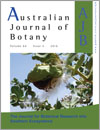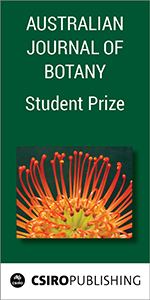Australian Journal of Botany
Volume 64
Number 5 2016
The female gametophyte plays a critical role in every step of the reproductive process. Therefore, studies of the ovule and female gametophyte are important for understanding plant reproduction. The tissues and cells involved in the female gametophyte are not fully studied. In this work the embryological characters analysed will contribute to the interpretation of possible phylogenetic relationships within the group of studied plants.
Since the late 19th century, surveyors have blazed trees to mark out paddock corners and boundary alignments. We used historic maps and a citizen science approach to locate old survey reference trees, document the types that occur and assess the factors affecting their condition. Many trees were 140 years old and in poor condition, but they represent an important legacy to past land-use history. As a form of living heritage, many trees are now succumbing to the ravages of time.
The study of floral development and vasculature is important for understanding floral evolution. The present paper used new data on the structure of mapaniid (Cyperaceae) reproductive units based on developmental and vasculature analyses, to confirm the hypothesis that they are not single flowers but reduced inflorescences composed of unisexual flowers. Considering the few number of studies concerning the reproductive units of Mapanioideae, the present study helps shed light in the understanding of their structure and evolution in the subfamily.
Seed dormancy is prevalent in arid ecosystems and prevents germination when used in broadacre seeding programs. Physical dormancy, or ‘hard seededness’, in seeds from the Fabaceae and Malvaceae is commonly encountered. Wet heat promoted seed dormancy break more consistently than dry-heat treatments (e.g. 70−90°C in water, for 2 or 5 min). However, contrary to many pretreatment recommendations, viability loss was detected at temperatures >90°C for some species and should be avoided.
Fire has a major influence on the structure and composition of temperate grasslands across the globe. Fire exclusion over a 10 year period led to declines in native species richness and abundance at two spatial scales. Furthermore, interactions between fire and soil texture influenced how grassland communities (individual species, origin and substrate) responded to fire; suggesting that underlying soil conditions should be considered in grassland fire management.
Examination of pollen and charcoal in freshwater lagoon sediments deposited over the last 600 years in the Midlands of Tasmania revealed that early 19th century European land-use disrupted an Aboriginal tradition of low intensity burning, established exotic woody and herbaceous plants, and caused population declines of some native plants.
In northern Australia, dense infestations of rubber bush pose an increasing threat to sustainability of pasture production and plant biodiversity. Some aspects of its seed biology were studied. Rubber bush seeds are highly germinable and can germinate within 3 days, provided external conditions are favourable. This short germination time, particularly under high water stress, may ensure its successful establishment but also its continual invasion of the relatively drier regions of the Australian continent.
Fire is an important factor affecting the viability and germination of seeds in the soil seed bank. We evaluated the effects of heat on germination and seed viability of three native perennials winter grasses of central Argentina. Our results suggest that the current management recommendations for the use of controlled fire may not be optimal for the palatable species.
Climate change is causing temperature patterns to change, which can affect co-occurring tree species differently and lead to changes in vegetation communities. We assessed the effects of low temperatures on three Eucalyptus species and found that they have different susceptibilities to low temperatures. Despite warming temperatures regionally, extreme low-temperature events are occurring more frequently in parts of south-western Australia, which may cause communities to change over the long term.




